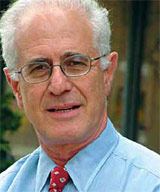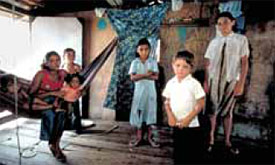Genetics in the Service of the People
by Paula Andaló
Advances in genomics can—and should—lead to progress in public health.
Back in the sixties when he was a student leader at the University of Buenos Aires, Victor Penchaszadeh had no idea that the famous DNA spiral discovered by James Watson just a decade earlier would become the cornerstone of his own professional life. But had he known, he might have guessed that his personal mission would one day be to combine genetics with social medicine and the promotion of health as a human right.

Argentine geneticist Victor Penchaszadeh.
Today, at the pinnacle of a 40-year career that has spanned pediatrics, epidemiology, and bioethics as well as genetics, Penchaszadeh is adamant in his belief that the benefits of the genomics revolution should not be a luxury for the rich but instead be within everyone's reach.
"Genetics may seem secondary to a society's basic needs, but it really needs to be integrated into general health services," he says.
To promote this idea, Penchaszadeh teamed up in 1996 with the Pan American Health Organization and the World Health Organization to establish the PAHO/WHO Collaborating Center on Community Genetics at the Mailman School of Public Health at Columbia University in New York. Now, a decade later, he has returned to his native Argentina to start a regional program on Medical Genetics and Public Health, housed at PAHO's country office in Buenos Aires. The program will help Latin American and Caribbean countries assess the safety and effectiveness of new genetic technologies and will produce policy documents on technical and bioethical issues related to genetics, health, and human rights.
Not just testing
For Penchaszadeh, genetic services are a public health tool that must be put at the service of the people. The reasons are simple and practical: knowing that someone has, or is predisposed to, a given illness or condition can help them avert the most serious consequences of that illness. Many genetically determined conditions are preventable or at least benefit from early treatment. And today, "there are at least 1,000 disorders that can be diagnosed through DNA analysis, either in an affected individual or through a prenatal test in early pregnancy," notes Penchaszadeh.
Many of these conditions can have an impact on collective health, in both rich and poorer countries. Examples include sickle cell disease, which is common in Cuba, and Huntington's disease, which has unusually high incidence in the Lake Maracaibo region of Venezuela.
But the link between genetic services and public health is not always appreciated, says Penchaszadeh. "The countries that have managed to have an impact on these diseases have acted at the level of primary health care, using effective prevention technologies," he observes.
To serve public health, he explains, genetic services must consist of more than testing; they must encompass diagnosis, treatment, follow-up, and counseling of patients at risk or suffering from genetic conditions.
Reclaiming lost identities

Genetic testing has helped Grandmothers of the Plaza de Mayo identify dozens of their long-lost grandchildren.
(Photo courtesy of Télam)
Victor Penchaszadeh has helped pioneer the use of genetic testing in recovering lost identity through his efforts to identify children illegally taken from captive birth mothers during Argentina's period of military dictatorship.
From 1976 to 1983, hundreds of Argentine women suspected of being leftists were kidnapped and taken to clandestine prisons. Many who were pregnant were killed after giving birth and their babies turned over to military families or others sympathetic to the military regime. The organization Grandmothers of the Plaza de Mayo estimates that some 250 or more children were illegally adopted in this manner.
With the return to democracy, former Argentine president Raúl Alfonsín formed a commission to investigate these and other human right abuses during the military era, and efforts to recover disappeared children intensified.
Acting on Penchaszadeh's recommendations, the Department of Health of the city of Buenos Aires set up a genetics laboratory at Durand General Hospital, which would later become the National Genetics Data Base. Its task was to collect and analyze genetic information to help establish the true identities of hundreds of young people whose biological parents had been victims of the military regime.
So far, around 90 young adults have been positively identified as among the babies who were "appropriated" from biological mothers killed in captivity. But the work of tracking these unknowing victims goes on, spurred in large part by the Grandmothers of the Plaza de Mayo, for whom Penchaszadeh serves as advisor. The grandmothers believe that as their lost grandchildren get older, more will come forward and be willing to confront the painful truth: that they may have been raised by people who had a direct or indirect hand in the torture and assassination of their true parents.
In practice, genetic services have developed erratically in Latin America and the Caribbean over the past decade. In nearly all the region's countries, genetic services are heavily concentrated in cities and promoted more by individual providers than by government health authorities motivated by public health concerns. This situation promotes inequity at the level of individual care, says Penchaszadeh, since access to genetic services is effectively limited to patients with money. It also skews the focus of genetic services.
"It runs the risk that genetic services can end up limited to private health care, with a focus on expensive procedures like chromosome analysis, prenatal diagnostics, and paternity testing"-and with little attention to prevention and follow-up.
Penchaszadeh says a singular exception to this trend is Cuba, where "genetic services were incorporated into basic health services from the beginning, with clear community objectives."
Meanwhile, in some countries of the region, clinical genetics does not yet exist as a medical specialty.
Seeking support
There are a number of barriers to further progress. Chief among them is the region's more obvious need to deal with priorities such as infectious and nutrition-related diseases, which makes it harder to view genetics as a primary health tool. And there are widely held misconceptions about genetics: for example, that it is inherently expensive and deals only with rare and exotic diseases, or that its preventive value is linked to pregnancy termination, which remains illegal in most countries of Latin America.
Penchaszadeh counters the latter by arguing: "Genetics has an under-appreciated preventive value. How many neural tube defects could be prevented if we promoted consumption of folic acid during pregnancy?"
Despite the economic and cultural obstacles, there are today in Latin America some 500 doctors specializing in clinical genetics and providing a range of services to patients. At the academic level, there are formal training programs in medical genetics in Argentina, Brazil, Chile, Cuba, and Mexico. In addition, many of the region's countries have professional associations linking experts in the field, and recently the Latin American Network of Human Genetics (RELAGH) became the region's representative organization to the International Society of Human Genetics Societies.
"Official support for these initiatives is crucial to put them in a framework of equity and accessibility in order for them to have a real impact on public health," says Penchaszadeh.
Government support is important for another reason. If genetic services are endorsed by governments, this guarantees some regulation, not only of procedures but of the uses of genetic information collected on patients. The issue goes beyond patient confidentiality into the realm of bioethics. "We mustn't forget that under the guise of genetics, people have embraced dangerous theories about genetic determinism and racial superiority," says Penchaszadeh.
He adds that there is the risk that, in the interest of prevention, genetics programs can undermine reproductive rights and increase discrimination against people with disabilities. To prevent such problems, WHO includes a strong bioethical component in all its programs for prevention and treatment of genetic diseases.
For Penchaszadeh, a key task is deciding which tools and methods are most efficient at the population level, for not only detection but also prevention of genetic disorders. Primary prevention of neural tube defects, for example, is a simple-if not yet routine-matter of fortifying diets with folic acid. Even Down syndrome can be prevented, by raising awareness about the impact of maternal age and discouraging childbearing among older women. Yet despite this, "in practice, programs on Down syndrome are mostly limited to screening of high-risk pregnancies using fetal chromosome analysis, after which there are two choices: continuing or interrupting the pregnancy," says Penchaszadeh. That presents parents with a dilemma that has not only moral but also-in most of the region's countries-legal implications.
At home in Buenos Aires, where he recently resettled after 25 years in the United States, Penchaszadeh insists that genetics is today at a crossroads. Its supporters must clearly define the ethical framework and the appropriate applications of genetics if they hope to move forward.
The challenge is twofold, he says: "to accelerate research on preventive and therapeutic applications of knowledge derived from genomics, and to ensure that these benefits are accessible to the population as a whole."
Paula Andaló is an Argentine journalist and former staff member of the Pan American Health Organization's Office of Public Information.
Founders and clusters
There are some 4,000 known genetic disorders, and "virtually all of them exist in Latin America," says Victor Penchaszadeh. Some of the most common include Down syndrome, cystic fibrosis, muscular dystrophy, hemophilia, sickle cell disease, Tay sachs disease, fragile X syndrome, and Huntington's disease.

Members of this family from Laguneta, Venezuela, near Lake Maracaibo, are at high risk of Huntington's disease, a rare genetic disorder that is found in an unusually high number of residents of this area. The DNA of the boy in the white shirt helped researchers identify the gene that causes the disease. (Photo by Steve Uzzell)
Many genetic disorders show up with greater frequency in specific population groups. Sickle cell disease, for example, is found most commonly in Africa and among Afro-descendants in the United States, the Caribbean Islands, South America's Atlantic coast, and Brazil. Other genetic disorders that "cluster" in Latin America include the following:
- Huntington's disease, a neurologically degenerative disorder that affects an unusually high proportion of people living in Venezuela's Lake Maracaibo region.
- Machado-Joseph disease, a form of spinocerebellar ataxia (with effects similar to Huntington's disease), that appears primarily in people of Portuguese-Azorean descent and is found with high frequency in southern Brazil.
- Holguín ataxia, named after the province in Cuba where the highest incidence of this disease is found.
- Albinism, which has unusually high incidence in Argentina's La Rioja region.
- Acheiropodia, which consists of congenitally amputated hands and feet, and has been found almost exclusively in Brazil.
Scientists believe that most clusters of this type are the result of what is known as the "founder effect," in which a small group of migrants settle a new area. If for geographical or cultural reasons their progeny tend to marry within the group, their descendants' genetic diversity will eventually decline, and any genetic disorders carried by the founders will appear more frequently in succeeding generations.
Articles:
HIV: What You Know Can Help You
Genetics in the Service of the People
Columns:
First Word
Setting priorities
in health
Last Word
Unhealthy competition
For Printing:
![]() PDF Version (2.7Mb)
PDF Version (2.7Mb)

